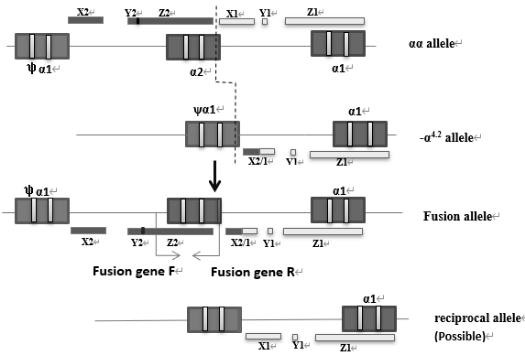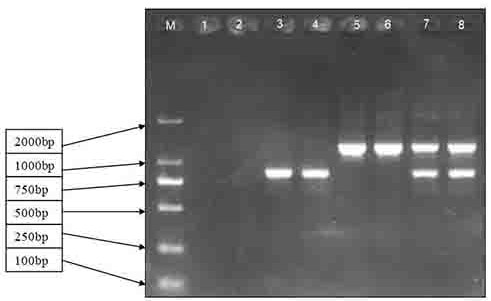Alpha-thalassemia related gene detection kit
A thalassemia and kit technology, which is applied in the determination/examination of microorganisms, DNA/RNA fragments, recombinant DNA technology, etc., can solve the problems of missing α-globin fusion gene Fusiongene detection and wrong prenatal diagnosis results, etc. The effect of easy promotion, intuitive interpretation of results, and low cost
- Summary
- Abstract
- Description
- Claims
- Application Information
AI Technical Summary
Problems solved by technology
Method used
Image
Examples
Embodiment 1
[0038] Example 1 Design and screening of primers for detection of α-globin fusion gene
[0039] Due to the high homology and high GC content among the α gene clusters, it is very difficult to amplify by ordinary PCR, and the expected product is often not obtained, and the specificity is poor, especially for the amplification of large fragments of repeat sequences with high GC content. difficulty. The reason may be that when such fragments are used as templates, the primers and templates tend to form stable secondary structures during annealing, hindering the progress of DNA polymerase on the templates, and there may be multiple non-specific primer local annealing sites on the templates. point, leading to non-specific amplification, and high GC-content repetitive sequence amplification further increases the generation of non-specific amplification.
[0040] In order to avoid the occurrence of the above situation, the present invention optimizes the PCR primers and PCR program ...
Embodiment 2
[0057] Example 2 PCR Amplification System for Detecting α-globin Fusion Gene
[0058] The clinical positive samples used in Example 1 were used as fusion gene positive samples, and the clinical negative samples used in Example 1 were used as negative samples.
[0059] Using primers Fusion gene-F (SEQ ID NO: 2) and Fusion gene-R (SEQ ID NO: 3), multiple sets of experiments were designed to determine the best PCR amplification system.
[0060] Set the final concentration of primers in the range of 0.1-1 μM, MgCl 2 The final concentration range is 1.0-5.0 mM, the final concentration range of dNTPs is 100-500 μM; the final concentration range of DNA polymerase is 0.5-4 U / reaction.
[0061] 1. Preliminary determination of primers, MgCl 2 , dNTPs, DNA polymerase final concentration on the amplification efficiency and specificity
[0062] 1. Effect of final primer concentration on amplification efficiency and specificity
[0063] (1) Experimental method
[0064] The amount of fi...
Embodiment 3
[0094] Example 3 Determination of PCR amplification conditions for detecting α-globin fusion gene
[0095] 1. Experimental method
[0096] Using a conventional PCR system, the reaction conditions were optimized in the following steps, as shown in Table 6:
[0097] Table 6 Optimization of PCR amplification conditions
[0098]
[0099] The same method was used to determine the PCR amplification conditions and the PCR amplification system. After preliminary experiments, the test factor levels were obtained as shown in Table 7.
[0100] Table 7 Test factors and levels
[0101]
[0102] On the basis of the above-mentioned preliminary experiments, denaturation time, annealing temperature, annealing time, and extension time were selected as the investigation factors, and a 3-level 4-factor experiment was carried out to comprehensively study the orthogonal effects of these four factors on the amplification efficiency and specificity. The impact of sex, so as to determine the ...
PUM
 Login to View More
Login to View More Abstract
Description
Claims
Application Information
 Login to View More
Login to View More - R&D
- Intellectual Property
- Life Sciences
- Materials
- Tech Scout
- Unparalleled Data Quality
- Higher Quality Content
- 60% Fewer Hallucinations
Browse by: Latest US Patents, China's latest patents, Technical Efficacy Thesaurus, Application Domain, Technology Topic, Popular Technical Reports.
© 2025 PatSnap. All rights reserved.Legal|Privacy policy|Modern Slavery Act Transparency Statement|Sitemap|About US| Contact US: help@patsnap.com



